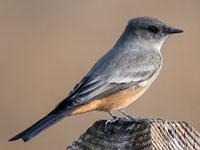BIRDS of THE WORLD - An Online Bird Book
Order Passeriformes Family Tyrannidae
New World FLYCATCHERs
Order Passeriformes Family Tyrannidae
The tyrant flycatchers (Tyrannidae) occur throughout North and South America. They are now considered the largest family of birds on Earth, with around 400 species. As could be expected from a family this large, the members vary greatly in habitat, shape, patterns and colors. Some Tyrant flycatchers superficially resemble the Old World flycatchers. Most, but not all, are rather plain, and many have erectile crests. Most are insectivorous, but some will eat fruit or small vertebrates.
The Tyrannidae family is presented in these web pages:
1) Tyrants, Black-Tyrants, Tit-Tyrants 2) Pygmy Tyrants, Tody-Flycatchers, Tody-Tyrants
3) Tyrants, Bush-Tyrants, Chat-Tyrants, Ground-Tyrants, Shrike Tyrants; Monjitas
4) Tyrannulets 5) Doradito, Elaenia, Tachuri
6) Flycatchers, Spadebills, Twistwings 7) Flycatchers, Pewees, Phoebes
8) Flycatchers, Attilas, Flatbills, Sirystes 9) Flycatchers, Kingbirds, Kiskadees
Flycatchers, Pewees, Phoebes
Genus Cnemotriccus - 1 species
Flycatcher,_Fuscous Cnemotriccus fuscatus Found: Brazil and surrounding countries
The Fuscous Flycatcher has brown upperparts; darker wings with 2 pale wing-bars; pale supercilium; black eye-line.
Image by: 1) Nick Athanas - Brazil 2) Ben Tavener - Brazil 3) Hector_Bottai 4) Luiz_Rocha - Brazil



Genus Contopus
The pewees are generally grayish birds with wing-bars. They live in wooded areas.
Flycatcher,_Olive-sided Contopus cooperi Found: The Americas
The Olive-sided Flycatcher has dark olive upperparts; light underparts; large dark bill; short tail.
Similar to: Greater Pewee. Greater Pewee has crest; Olive-sided Flycatcher does not. Great Pewee lower mandible is orange; Olive-sided Flycatcher has dark bill.
Image by: 1) Maggie Smith - California 2) Dominic Sherony 3) Len Blumin - California 4) Jerry Oldenettel - New MexicoSimilar to: Greater Pewee. Greater Pewee has crest; Olive-sided Flycatcher does not. Great Pewee lower mandible is orange; Olive-sided Flycatcher has dark bill.



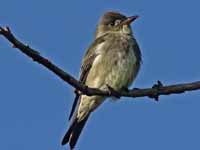
Pewee,_Blackish Contopus nigrescens Found: mainly; Ecuador, Peru; also Brazil
The Blackish Pewee has sooty gray to blackish plumage; paler lores; narrow white eye-rings.
Image by: 1) Nick Athanas - Brazil 2) Cornell_Univ's_Neotropical_Birds_Online - Roger_Ahlman

Pewee,_Cuban Contopus caribaeus Found: Cuba, Bahamas
Image by: 1, 2, 3) Ken Schneider - Long Pine Key, Everglades National Park 4) Victoria Garcia - Cuba


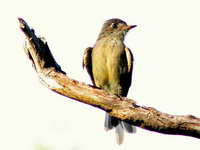
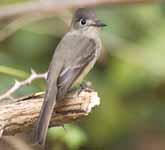
Pewee,_Dark Contopus lugubris Found: Costa Rica and Panama
The Dark Pewee has sooty-gray upperparts, darkest on the crested crown; blackish wings and tail; faint wing-bar; pale gray throat; light olive-gray underparts becoming yellowish on the lower belly.
Similar to: Western Wood-Pewee. Western Wood-Pewee has obvious wing-bars; Dark Pewee has darker underparts.
Image by: Dominic Sherony 2) Nick Athanas - Costa RicaSimilar to: Western Wood-Pewee. Western Wood-Pewee has obvious wing-bars; Dark Pewee has darker underparts.

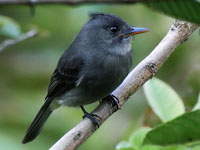
Pewee,_Eastern_Wood- Contopus virens Found:North America, South America
The Eastern Wood-Pewee has olive-gray upperparts; washed olive on the breast; 2 white wing-bars; dark upper-tail; yellowish under-tail; dark upper mandible; yellowish lower mandible.
Similar to: Eastern Phoebe. Eastern Wood-Pewee has more distinct wing-bars than Eastern Phoebe. Eastern Phoebe bobs its tail frequently.
Similar to: Greater Pewee. Greater Pewee has a crest, indistinct wingbars; Eastern Wood-Pewees does have a crest and has distinct wingbars.
Similar to: Tropical Pewee. Tropical Pewee usually has wite lores (photo 2); Eastern Wood-Pewee does not.
Similar to: Western Wood-Pewee. Difficult to distinguish by appearance, but there is little overlap of range. Voice is an identifiable feature.
Image by: 1) Kelly Azar 2) Sid Phillips - Tennessee 3) Jim Conrad 4) Michael Hodge - Tennessee 5) Jerry Oldenettel - New MexicoSimilar to: Eastern Phoebe. Eastern Wood-Pewee has more distinct wing-bars than Eastern Phoebe. Eastern Phoebe bobs its tail frequently.
Similar to: Greater Pewee. Greater Pewee has a crest, indistinct wingbars; Eastern Wood-Pewees does have a crest and has distinct wingbars.
Similar to: Tropical Pewee. Tropical Pewee usually has wite lores (photo 2); Eastern Wood-Pewee does not.
Similar to: Western Wood-Pewee. Difficult to distinguish by appearance, but there is little overlap of range. Voice is an identifiable feature.
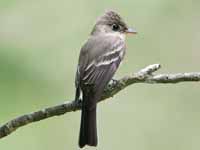




Pewee,_Greater Contopus pertinax Found: southwest North America, Central America
The Great Pewee is slightly longer than the Olive-sided Pewee; hence the name. It has dull gray-brown plumage; distinct crest; indistinct wing-bars; long bill; orange lower mandible.
Similar to: Eastern Wood-Pewee, Western Wood-Pewee. Greater Pewee has a crest, indistinct wingbars; Eastern and Western Wood-Pewees do not have a crest and have distinct wingbars.
Similar to: Olive-sided Flycatcher. Greater Pewee has crest; Olive-sided Flycatcher does not. Great Pewee lower mandible is orange; Olive-sided Flycatcher has dark bill.
Image by: 1) Amy McAndrews - Mexico 2) Jerry Oldenettel - Texas Nick Athanas - MexicoSimilar to: Eastern Wood-Pewee, Western Wood-Pewee. Greater Pewee has a crest, indistinct wingbars; Eastern and Western Wood-Pewees do not have a crest and have distinct wingbars.
Similar to: Olive-sided Flycatcher. Greater Pewee has crest; Olive-sided Flycatcher does not. Great Pewee lower mandible is orange; Olive-sided Flycatcher has dark bill.

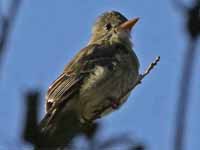

Pewee,_Hispaniolan Contopus hispaniolensis Found: Dominican Republic, Haiti
Image by: 1) Carlos De Soto Molinari 2) Ron_Knight


Pewee,_Jamaican Contopus pallidus Found: Jamaica
The Jamaican Pewee has olive-brown upperparts; darker wings, tail; paler underparts.
Image by: 1) Charles_J_Sharp 2) Ron_Knight

Pewee,_Lesser_Antillean Contopus latirostris Found: Dominica, Guadeloupe, Martinique, Puerto Rico, Saint Lucia
The Lesser Antillean Pewee has dark olive-brown upperparts. Underparts: rufus-cinnamon (St, Lucia), buffy (Puerto Rico); paler on other islands.
Image by: 1) Joshua_Stone - Puerto Rico 2) Fleviez - Guadeloupe 3) Marcel_Holyoak - St Lucia


Pewee,_Ochraceous Contopus ochraceus Found: Costa Rica, Panama
The Ochraceous Pewee has ochre breast, wing-bars; crest.
Similar to: Tufted Flycatcher. Ochraceous Pewee is much larger; has ochre breast. Tufted Flycatcher has larger crest; tawny breast.
Image by: 1) Cornell_Univ's_Neotropical_Birds_Online - Andrew_Spencer, Glenn_Bartley 2) Jorge_Obando_Gutierrez Similar to: Tufted Flycatcher. Ochraceous Pewee is much larger; has ochre breast. Tufted Flycatcher has larger crest; tawny breast.


Pewee,_Smoke-colored Contopus fumigatus Found: Venezuela to Argentina
The Smoke-colored Pewee, Greater Pewee, and Dark Pewee were formerly consider conspecific. Smoke-colored Pewee range is south of these other two species.
Image by: 1) Joao_Quental 2) Nick Athanas - Ecuador

Pewee,_Tropical Contopus cinereus Found: southern Mexico to South America
The Tropical Pewee has gray or dark brown upperparts; blackish crown; 2 white wing-bars; white lores; whitish throat and center of breast; gray-brown flanks; pale yellow belly.
Similar to: Eastern Wood-Pewee. Tropical Pewee usually has wite lores (photo 2); Eastern Wood-Pewee does not.
Image by: 1, 2, 3) Nick Athanas - Ecuador, Brazil, Costa Rica 4) AmyMcAndrews 5) Erick Houk Similar to: Eastern Wood-Pewee. Tropical Pewee usually has wite lores (photo 2); Eastern Wood-Pewee does not.

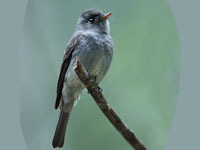


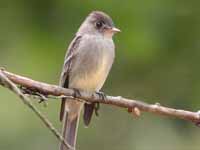
Pewee,_Western_Wood- Contopus sordidulus Found: North America, South America
The Western Wood-Pewee has gray-olive upperparts; light underparts washed with olive on the breast; 2 white wing-bars; dark bill with yellow at the base of the lower mandible.
Similar to: Dark-Pewee. Western Wood-Pewee has obvious wing-bars; Dark Pewee has darker underparts.
Similar to: Greater Pewee. Greater Pewee has a crest, indistinct wingbars; Western Wood-Pewees does have a crest and has distinct wingbars.
Similar to: Eastern Wood-Pewee. Difficult to distinguish by appearance, but there is little overlap of range. Voice is an identifiable feature.
Image by: 1) Alan D Wilson 2) Arthur Chapman near Brooks, Alberta 3, 4) J N Stuart - New Mexico 5) Bill Bouton - California 6) Nick Athanas - EcuadorSimilar to: Dark-Pewee. Western Wood-Pewee has obvious wing-bars; Dark Pewee has darker underparts.
Similar to: Greater Pewee. Greater Pewee has a crest, indistinct wingbars; Western Wood-Pewees does have a crest and has distinct wingbars.
Similar to: Eastern Wood-Pewee. Difficult to distinguish by appearance, but there is little overlap of range. Voice is an identifiable feature.






Pewee,_White-throated Contopus albogularis Found: Suriname, French Guiana, extreme northeastern Brazil
The White-throated Pewee has dark gray upperparts; paler underparts; white throat.
Image by: 1) Thierry_Nogaro Cornell_Univ's_Neotropical_Birds_Online - Thierry_Nogaro
Genus Empidonax
The various species of this genus are quite similar in appearance. Another characteristic they share is rapid flicking of their tails and wings. During the nesting season they may be distinguished by range, habitat, and call. See Sibley for calls of North American birds.
Flycatcher,_Acadian Empidonax virescens Found: The Americas
The Acadian Flycatcer has olive upperparts with darker wings and tail; whitish underparts with the breast washed with olive; whte eye-ring; 2 white wing-bars; dark upper bill, yellowish lower bill. The
song is an explosive peet-sa. The call is a soft peet.
Similar to: Alder Flycatcher, Willow Flycatcher. Acadian Flycatcher is greener and larger.
Image by: 1) Dan Shustack - Ohio fledgling 2, 3, Kelly Azar - Deleware
4) Joby Joseph - Maryland 5) Dominic Sherony 6) TrolleySimilar to: Alder Flycatcher, Willow Flycatcher. Acadian Flycatcher is greener and larger.


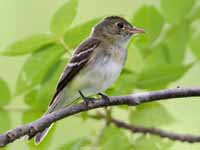
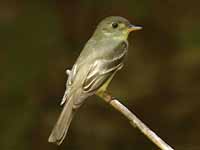
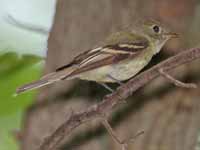

Flycatcher,_Alder Empidonax alnorum Found: The Americas
The Alder Flycatcerh Flycatcher has olive-brown upperparts, browner on wings and tail; whitish underparts with the breast washed with olive-gray; white eye-ring; 2 white wing-bars; gray upper bill; orangish lower bill. The
song is a wheezed wee-bee. The call is a quick preet.
Similar to: Acadian Flycatcher. Acadian Flycatcher is greener and larger.
Similar to: Willow Flycatcher. Alder Flycatcher and Willow Flycatcher are very similar; best identified by voice.
Image by: 1, 4) Cephas - Quebec 2) Merv Cormier 3) Jerry Oldenettel - Wisconsin 5) Caleb Siemmons Similar to: Acadian Flycatcher. Acadian Flycatcher is greener and larger.
Similar to: Willow Flycatcher. Alder Flycatcher and Willow Flycatcher are very similar; best identified by voice.
1) Juvenile
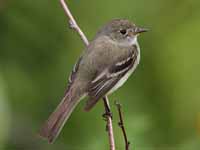



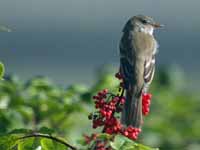
Flycatcher,_Black-capped Empidonax atriceps Found: Costa Rica, Panama
The Black-capped Flycatcher has olive-brown upperparts; black crown, nape; pale brown underparts becoming yellow on lower-belly.
Image by: 1) Nick Athanas - Costa Rica 2) Brendan_Ryan 3) Francesco_Veronesi - Costa Rica


Flycatcher,_Buff-breasted Empidonax fulvifrons Found: southwest North America and Central America
The Buff-breasted Flycatcher has olive-gray upperparts with darker wings and tail; conspicuous white eye-rings; 2 white wing-bars; distinctive orange-buff breast. It is the smallest Empidonax flycatcher.The
song is an alternating versed PIdew, piDEW. The call is a loud dry pit.
Image by: 1) Dominic Sherony 2) Alejandra_Mercado 3) Pablo Leautaud


Flycatcher,_Cordilleran Empidonax occidentalis Found: North America
The Cordilleran Flycatcher has olive-gray upperparts with darker wings and tail; tear-dropped shape white eye-ring; 2 white wing-bars; yellowish underparts.
Similar to: Pacific-slope Flycatcher. These 2 species are virtually identical in appearance. Cordilleran Flycacher breeds in the Rocky Mountains and Pacific-slope breeds nearer to the Pacific coast. Their calls are different.
Image by: 1) Jerry Friedman - New Mexico 2) John_Matthews 3, 4) Jerry Oldenettel - New MexicoSimilar to: Pacific-slope Flycatcher. These 2 species are virtually identical in appearance. Cordilleran Flycacher breeds in the Rocky Mountains and Pacific-slope breeds nearer to the Pacific coast. Their calls are different.
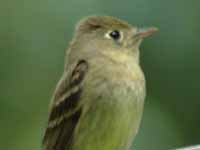



Flycatcher,_Dusky also American Dusky Flycatcher Empidonax oberholseri Found: western North America
The Dusky Flycatcher has olive-gray upperparts with darker wings and tail; whitish underparts with the breast washed with olive-gray ; bold medium-with eye-ring; mainly dark bill.
Similar to: Gray Flycatcher, Hammond's Flycatcher. Very similar in appearance. Bill size from smaller to larger: Hammond's Flycatcher, Dusky Flycatcher, Gray Flycatcher. Dusky usually found in low brush, small trees; Gray Flycatcher prefers low vegetation in arid environment; Hammond's found high in conifers.
Image by: 1) Jamie Chavez - California 2) Nick Athanas - Mexico 3) Jamie_Robles - Mexico 4, 5) Jerry Oldenettel - New Mexico 6) Marcel Holyoak - CaliforniaSimilar to: Gray Flycatcher, Hammond's Flycatcher. Very similar in appearance. Bill size from smaller to larger: Hammond's Flycatcher, Dusky Flycatcher, Gray Flycatcher. Dusky usually found in low brush, small trees; Gray Flycatcher prefers low vegetation in arid environment; Hammond's found high in conifers.
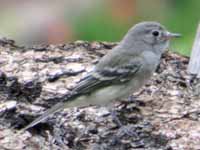





Flycatcher,_Gray also American Gray Flycatcher Empidonax wrightii Found: western North America
Th Gray Flycatcher has pale gray upperparts, darker on wings and tail; whitish underparts, washed with pale yellow in gresh plumage; 2 white wing-bars; white eye-ring;
Only the male Gray Flycatcher sings. The song is a strong, two syllable note described as chuwip or wilip. A weaker, higher-pitched teeap or seep is often inserted into the song. Both sexes give a dry pit or wit call.
Similar to: Dusky Flycatcher. Hammond's Flycatcher. Very similar in appearance. Bill size from smaller to larger: Hammond's Flycatcher, Dusky Flycatcher, Gray Flycatcher. Dusky usually found in low brush, small trees; Gray Flycatcher prefers low vegetation in arid environment; Hammond's found high in conifers.
Image by: 1, 3) Jerry Oldenettel - New Mexico 2) Aaron_Maizlish - CA 4) mememorice - Mexico 5) Erin and Lance Willett 6) Bryan and Jess - Washington Only the male Gray Flycatcher sings. The song is a strong, two syllable note described as chuwip or wilip. A weaker, higher-pitched teeap or seep is often inserted into the song. Both sexes give a dry pit or wit call.
Similar to: Dusky Flycatcher. Hammond's Flycatcher. Very similar in appearance. Bill size from smaller to larger: Hammond's Flycatcher, Dusky Flycatcher, Gray Flycatcher. Dusky usually found in low brush, small trees; Gray Flycatcher prefers low vegetation in arid environment; Hammond's found high in conifers.






Flycatcher,_Hammond's Empidonax hammondii Found: western North America
Hammond's Flycatcher song is a multi versed hoarse ssilit, greeep, silit, pweet. The call is a sharp peek.
Similar to: Dusky Flycatcher, Gray Flycatcher. Very similar in appearance. Bill size from smaller to larger: Hammond's Flycatcher, Dusky Flycatcher, Gray Flycatcher. Dusky usually found in low brush, small trees; Gray Flycatcher prefers low vegetation in arid environment; Hammond's found high in conifers.
Similar to: Least Flycatcher. Least Flycatcher is the smallest Empidonax flycatcher in North America. Least Flycatcher has bolder wing-bars than Hammond's Flycatcher. Both have bold white eye-rings.
Image by: 1) Alan
Vernon - Hyder, Alaska 2) Pablo Leautaud - Mexico 3) Len Blumin - California 4) Rick Leche 5) Bill Bouton - Californi 6) Mark Watson - New Mexico Similar to: Dusky Flycatcher, Gray Flycatcher. Very similar in appearance. Bill size from smaller to larger: Hammond's Flycatcher, Dusky Flycatcher, Gray Flycatcher. Dusky usually found in low brush, small trees; Gray Flycatcher prefers low vegetation in arid environment; Hammond's found high in conifers.
Similar to: Least Flycatcher. Least Flycatcher is the smallest Empidonax flycatcher in North America. Least Flycatcher has bolder wing-bars than Hammond's Flycatcher. Both have bold white eye-rings.
1) Juvenile






Flycatcher,_Least Empidonax minimus Found: North America and Central America
The Least Flycatcher has grayish-oliver upperparts, darker on the wings and tail; whitish underparts, breast washed with gray, sides of belly washed with yellow; white eye-rings; 2 white wing-bars. The
song is a dry che-bec. The call is a sharp whit.
Similar to: Hammond's Flycatcher. Least Flycatcher is the smallest Empidonax flycatcher in North America. Least Flycatcher has bolder wing-bars than Hammond's Flycatcher. Both have bold white eye-rings.
Similar to: Yellow-bellied Flycatcher. Yellow-bellied Flycatcher has yellowish underparts; Least Flycatcher does not. Yellow-bellied Flycatcher's call note is transcribed as chu-wee, ascending in pitch; Least Flycatcher's is CHE-bek.
Image by: 1) Mdf 2) Dominic Sherony 3) Dale Kaskey 4) Seabamirum 5) David MitchellSimilar to: Hammond's Flycatcher. Least Flycatcher is the smallest Empidonax flycatcher in North America. Least Flycatcher has bolder wing-bars than Hammond's Flycatcher. Both have bold white eye-rings.
Similar to: Yellow-bellied Flycatcher. Yellow-bellied Flycatcher has yellowish underparts; Least Flycatcher does not. Yellow-bellied Flycatcher's call note is transcribed as chu-wee, ascending in pitch; Least Flycatcher's is CHE-bek.
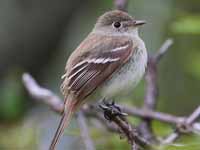




Flycatcher,_Pacific-slope Empidonax difficilis Found: Coast regions of western North America
The Pacific-slope Flycatcher has olive-gray upperparts with darker wings and tail; tear-dropped shape white eye-ring; 2 white wing-bars; yellowish underparts.
Similar to: Cordilleran Flycatcher. These 2 species are virtually identical in appearance. Cordilleran Flycacher breeds in the Rocky Mountains and Pacific-slope breeds nearer to the Pacific coast. Their calls are different.
Image by: 1) Bill Bouton - California 2) Teddy Liovel 3) Becky_Matsubara - California 4) Ron_Knight 4) Linda Tanner - California Similar to: Cordilleran Flycatcher. These 2 species are virtually identical in appearance. Cordilleran Flycacher breeds in the Rocky Mountains and Pacific-slope breeds nearer to the Pacific coast. Their calls are different.





Flycatcher,_Pine Empidonax affinis Found: mainly Mexico; also Guatemala
The Pine Flycatcher resides in pine forests.
Image by: 1) Ron_Knight 2) Canicas123 3) Alejandra_Mercado

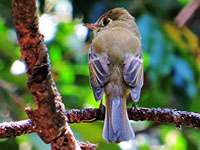
Flycatcher,_White-throated Empidonax albigularis Found: Mexico, Central America
The White-throated Flycatcher has brownish-green upperparts; paler underparts; white throat. Its nasal song is its best distinguishing feature.
Image by: 1, 2) Amy_McAndrews - Mexico

Flycatcher,_Willow Empidonax traillii Found: North America, northwest South America
The Willow Flycatcher hase brown-olive upperparts; whitish underparts with the breast washed with olive-gray; gray upper part of bill; orangish lower part of bill. It's
song is a sneezed fitz-bew. The call is a dry whit.
Similar to: Acadian Flycatcher. Acadian Flycatcher is greener and larger.
Similar to: Alder Flycatcher. Alder Flycatcher and Willow Flycatcher are very similar; best identified by voice.
Image by: 1,
4) Kelly Azar - Pennsylvania 2)Bill Bouton - California 3)
Sid Phillips - Tennessee Similar to: Acadian Flycatcher. Acadian Flycatcher is greener and larger.
Similar to: Alder Flycatcher. Alder Flycatcher and Willow Flycatcher are very similar; best identified by voice.




Flycatcher,_Yellow-bellied Empidonax flaviventris Found: east North America
The Yellow-bellied Flycatcher has greenish upperparts; yellowish underparts with a dusky wash on the breast; white or yellowish eye-ring; dark upper mandible; orange-pink lower mandible. The
call is chu-wee, ascending in pitch.
Similar to: Least Flycatcher. Yellow-bellied Flycatcher has yellowish underparts; Least Flycatcher does not. Yellow-bellied Flycatcher's call note is transcribed as chu-wee, ascending in pitch; Least Flycatcher's is CHE-bek.
Similar to: Yellowish Flycatcher. Yellowish Flycatcher is the brightest yellow of the Empidonax flycatchers.
Image by: 1) Seabrooke Leckie 2,4) Jerry Oldenettel - New Mexico 3) Seabamirum - New York 5) Cephas - Quebec Similar to: Least Flycatcher. Yellow-bellied Flycatcher has yellowish underparts; Least Flycatcher does not. Yellow-bellied Flycatcher's call note is transcribed as chu-wee, ascending in pitch; Least Flycatcher's is CHE-bek.
Similar to: Yellowish Flycatcher. Yellowish Flycatcher is the brightest yellow of the Empidonax flycatchers.





Flycatcher,_Yellowish Empidonax flavescens Found: Mexico to Panama
Yellowish Flycatcher has olive-green upperparts; yellowish underparts; pale-yellow asymmetical eye-ringcall; 2 yellowish wingbars.
Similar to: Yellow-green Tyrannulet. Yellow-green Tyrannulet has thin symmetrical eye-ring; Yellowish Flycatcher has broad asymmetrcial eye-ring.
Similar to: Yellow-bellied Flycatcher. Yellowish Flycatcher is the brightest yellow of the Empidonax flycatchers.
Image by: 1) Jerry Oldenettel - Costa Rica 2) Bird Brian 3) Mdf - Panama 4) Steve Ryan - Costa Rica
5) Dominic
Sherony 6, 7, 8) Dick Daniels - Boquette, PanamaSimilar to: Yellow-green Tyrannulet. Yellow-green Tyrannulet has thin symmetrical eye-ring; Yellowish Flycatcher has broad asymmetrcial eye-ring.
Similar to: Yellow-bellied Flycatcher. Yellowish Flycatcher is the brightest yellow of the Empidonax flycatchers.








Genus Lessonia
Negrito,_Andean Found: South America
The male Andean Negrito has black plumage with a yellow-brown cape. Female has dark-gray plumage with brownish cape. Found high wetlands of Peru to north Chile, northwest Argentina.
Similar to: Austral Negrito. Male Andean Negrito has yellowish tinge to its cape; male Austral Negrito has chestnut cape. Female Andean Negrito darker than female Austral Negrito. Andean Negrito found at higher altitude than Austral Negrito.
Image by: 1) Cornell_Univ's_Neotropical_Birds_Online - David_Samata_Flores 2) Joel Rosenthal - Peru 3) Francesco_Veronesi - ArgentinaSimilar to: Austral Negrito. Male Andean Negrito has yellowish tinge to its cape; male Austral Negrito has chestnut cape. Female Andean Negrito darker than female Austral Negrito. Andean Negrito found at higher altitude than Austral Negrito.
1) Female 2, 3) Male



Negrito, Austral also Patagonian Negrito Lessonia rufa Found: South America
The male Austral Negrito has black plumage with a chestnut cape. Female has brownish-gray head, back, wing coverts; dark primaries and tail; whitish-buff underparts with faint streaking.
Similar to: Andean Negrito. Male Andean Negrito has yellowish tinge to its cape; male Austral Negrito has chestnut cape. Female Andean Negrito darker than female Austral Negrito. Andean Negrito found at higher altitude than Austral Negrito.
Image by: 1, 2,, 4) Claudio Timm - Patagonia, Argentina 4) Dick Daniels - Chile 5) Cristiano Crolle - Las Gaviotas, ArgentinaSimilar to: Andean Negrito. Male Andean Negrito has yellowish tinge to its cape; male Austral Negrito has chestnut cape. Female Andean Negrito darker than female Austral Negrito. Andean Negrito found at higher altitude than Austral Negrito.
1) Juvenile 2, 3) Female 4, 5) Male


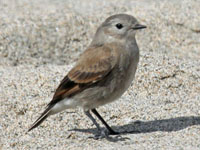


Genus Pyrocephalus - 1 species
Flycatcher,_Vermilion Pyrocephalus rubinus Found: southwest USA, South America
The male Vermillion Flycatcher has dark brown upperparts; bright red crown, underparts. Female has dark gray upperparts; peach belly.
Image by: 1 Francisco Laso - Galapagos 2) Pleautaud - Jalisco, Mexico 3) Charlie Westerinen - Peru 4) Andy_Morffew - Texas 5) Steve Bedard - Galapagos 6) Pablo Leautaud - Mexico 7) Charles & Clint 1) Juvenile femlae 2) Female 3) Sooty morph 4, 5, 6) Male







Genus Sayornis
Phoebes have a characteristic tail wag.
Phoebe,_Black Sayornis nigricans Found: The Americas
The Black Phoebe has predominently black plumage; white belly.
Similar to: Eastern Phoebe. Black Phoebe has black breast; Eastern Phoebe has light breast.
Similar to: Say's Phoebe. Black Phoebe has white belly; Say's Phoebe has orange-tinged belly. Black Phoebe has black breast; Say's Phoebe has light breast.
Image by: 1) Alan D Wilson - California 2) Becky_Matsubara - San Francisco 3) Dick - Half Moon Bay, California 4, 5, 6) Dick - Ecuador 7) Dick - Boquette, PanamaSimilar to: Eastern Phoebe. Black Phoebe has black breast; Eastern Phoebe has light breast.
Similar to: Say's Phoebe. Black Phoebe has white belly; Say's Phoebe has orange-tinged belly. Black Phoebe has black breast; Say's Phoebe has light breast.



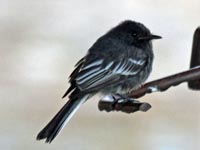



Phoebe,_Eastern Sayornis phoebe Found: North America, South America
The Eastern Phoebe has gray-brown upperparts; white throat; whitish underparts.
Similar to: Black Phoebe. Black Phoebe has black breast; Estern Phoebe has light breast.
Similar to: Eastern Wood-Pewee. Eastern Wood-Pewee has more distinct wing-bars than Eastern Phoebe. Eastern Phoebe bobs its tail frequently.
Similar to: Say's Phoebe. Eastern Phoebe has light belly; Say's Phoebe has orange-tinged belly.
Image by: 1) John Benson - Wisconsin 2) Cephas - Quebec 3) Dick Daniels - Maine 4) Dick - North Carolina Similar to: Black Phoebe. Black Phoebe has black breast; Estern Phoebe has light breast.
Similar to: Eastern Wood-Pewee. Eastern Wood-Pewee has more distinct wing-bars than Eastern Phoebe. Eastern Phoebe bobs its tail frequently.
Similar to: Say's Phoebe. Eastern Phoebe has light belly; Say's Phoebe has orange-tinged belly.
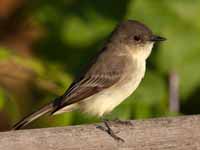



Phoebe,_Says Sayornis saya Found: North America
The Says Phoebe has gray-brown upperparts; darker head; black tail; pale buffy cinnamon underparts.
Similar to: Black Phoebe. Black Phoebe has white belly; Say's Phoebe has orange-tinged belly. Black Phoebe has black breast; Say's Phoebe has light breast.
Similar to: Eastern Phoebe. Eastern Phoebe has light belly; Say's Phoebe has orange-tinged belly.
Image by: 1) Kevin Cole 2) Wolfgang Wander 3) Becky_Matsubara - CA 4) Chris Queen Similar to: Black Phoebe. Black Phoebe has white belly; Say's Phoebe has orange-tinged belly. Black Phoebe has black breast; Say's Phoebe has light breast.
Similar to: Eastern Phoebe. Eastern Phoebe has light belly; Say's Phoebe has orange-tinged belly.


